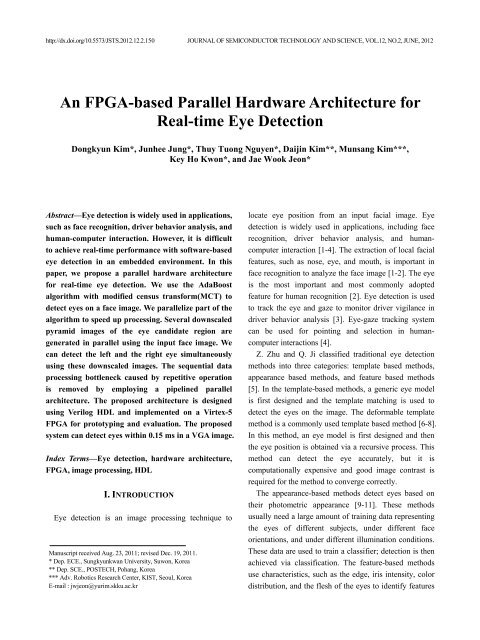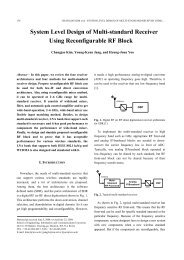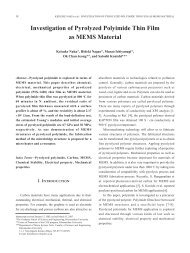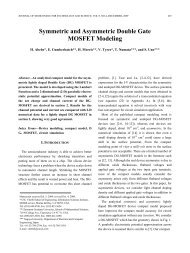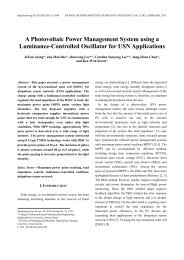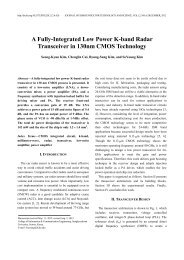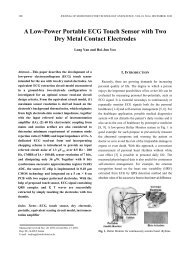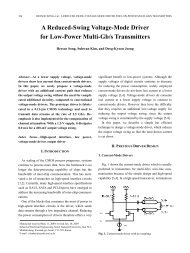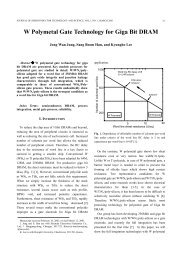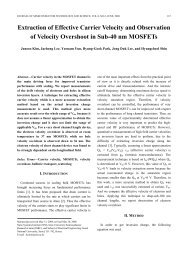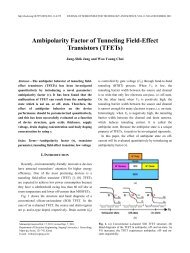An FPGA-based Parallel Hardware Architecture for Real-time ... - JSTS
An FPGA-based Parallel Hardware Architecture for Real-time ... - JSTS
An FPGA-based Parallel Hardware Architecture for Real-time ... - JSTS
Create successful ePaper yourself
Turn your PDF publications into a flip-book with our unique Google optimized e-Paper software.
http://dx.doi.org/10.5573/<strong>JSTS</strong>.2012.12.2.150 JOURNAL OF SEMICONDUCTOR TECHNOLOGY AND SCIENCE, VOL.12, NO.2, JUNE, 2012<br />
<strong>An</strong> <strong>FPGA</strong>-<strong>based</strong> <strong>Parallel</strong> <strong>Hardware</strong> <strong>Architecture</strong> <strong>for</strong><br />
<strong>Real</strong>-<strong>time</strong> Eye Detection<br />
Dongkyun Kim*, Junhee Jung*, Thuy Tuong Nguyen*, Daijin Kim**, Munsang Kim***,<br />
Key Ho Kwon*, and Jae Wook Jeon*<br />
Abstract—Eye detection is widely used in applications,<br />
such as face recognition, driver behavior analysis, and<br />
human-computer interaction. However, it is difficult<br />
to achieve real-<strong>time</strong> per<strong>for</strong>mance with software-<strong>based</strong><br />
eye detection in an embedded environment. In this<br />
paper, we propose a parallel hardware architecture<br />
<strong>for</strong> real-<strong>time</strong> eye detection. We use the AdaBoost<br />
algorithm with modified census trans<strong>for</strong>m(MCT) to<br />
detect eyes on a face image. We parallelize part of the<br />
algorithm to speed up processing. Several downscaled<br />
pyramid images of the eye candidate region are<br />
generated in parallel using the input face image. We<br />
can detect the left and the right eye simultaneously<br />
using these downscaled images. The sequential data<br />
processing bottleneck caused by repetitive operation<br />
is removed by employing a pipelined parallel<br />
architecture. The proposed architecture is designed<br />
using Verilog HDL and implemented on a Virtex-5<br />
<strong>FPGA</strong> <strong>for</strong> prototyping and evaluation. The proposed<br />
system can detect eyes within 0.15 ms in a VGA image.<br />
Index Terms—Eye detection, hardware architecture,<br />
<strong>FPGA</strong>, image processing, HDL<br />
I. INTRODUCTION<br />
Eye detection is an image processing technique to<br />
Manuscript received Aug. 23, 2011; revised Dec. 19, 2011.<br />
* Dep. ECE., Sungkyunkwan University, Suwon, Korea<br />
** Dep. SCE., POSTECH, Pohang, Korea<br />
*** Adv. Robotics Research Center, KIST, Seoul, Korea<br />
E-mail : jwjeon@yurim.skku.ac.kr<br />
locate eye position from an input facial image. Eye<br />
detection is widely used in applications, including face<br />
recognition, driver behavior analysis, and humancomputer<br />
interaction [1-4]. The extraction of local facial<br />
features, such as nose, eye, and mouth, is important in<br />
face recognition to analyze the face image [1-2]. The eye<br />
is the most important and most commonly adopted<br />
feature <strong>for</strong> human recognition [2]. Eye detection is used<br />
to track the eye and gaze to monitor driver vigilance in<br />
driver behavior analysis [3]. Eye-gaze tracking system<br />
can be used <strong>for</strong> pointing and selection in humancomputer<br />
interactions [4].<br />
Z. Zhu and Q. Ji classified traditional eye detection<br />
methods into three categories: template <strong>based</strong> methods,<br />
appearance <strong>based</strong> methods, and feature <strong>based</strong> methods<br />
[5]. In the template-<strong>based</strong> methods, a generic eye model<br />
is first designed and the template matching is used to<br />
detect the eyes on the image. The de<strong>for</strong>mable template<br />
method is a commonly used template <strong>based</strong> method [6-8].<br />
In this method, an eye model is first designed and then<br />
the eye position is obtained via a recursive process. This<br />
method can detect the eye accurately, but it is<br />
computationally expensive and good image contrast is<br />
required <strong>for</strong> the method to converge correctly.<br />
The appearance-<strong>based</strong> methods detect eyes <strong>based</strong> on<br />
their photometric appearance [9-11]. These methods<br />
usually need a large amount of training data representing<br />
the eyes of different subjects, under different face<br />
orientations, and under different illumination conditions.<br />
These data are used to train a classifier; detection is then<br />
achieved via classification. The feature-<strong>based</strong> methods<br />
use characteristics, such as the edge, iris intensity, color<br />
distribution, and the flesh of the eyes to identify features
JOURNAL OF SEMICONDUCTOR TECHNOLOGY AND SCIENCE, VOL.12, NO.2, JUNE, 2012 151<br />
around the eyes [12].<br />
There are several approaches to reduce eye detection<br />
processing <strong>time</strong>. These approaches can be broadly<br />
classified into two groups: software-<strong>based</strong> and hardware<strong>based</strong>.<br />
The focus in the software-<strong>based</strong> approach is<br />
designing and optimizing an eye detection algorithm <strong>for</strong><br />
real-<strong>time</strong> per<strong>for</strong>mance. Conversely, in the hardware<strong>based</strong><br />
approach, the eye detection algorithm is<br />
parallelized and implemented on DSP or <strong>FPGA</strong> to<br />
achieve real-<strong>time</strong> per<strong>for</strong>mance.<br />
T. D'Orazio et al. propose a real <strong>time</strong> eye detection<br />
algorithm [13]. They use iris geometrical in<strong>for</strong>mation to<br />
determine the eye region candidate and symmetry to<br />
select the pair of eyes. Their algorithm consists of two<br />
steps. First, the region candidate that contains one eye is<br />
detected from the whole image by matching the edge<br />
directions with an edge template of the iris. Then, in the<br />
opposite region, a search is carried out <strong>for</strong> the second eye,<br />
whose distance and orientation are compatible with the<br />
range of possible eye positions. The software has been<br />
implemented using Visual C++ on a Pentium III 1GHz.<br />
They use a camera with a frame rate of 7.5 fps. The<br />
search <strong>for</strong> the eyes in an image of 640×480 takes about<br />
0.3 sec.<br />
K. Lin et al. proposed a fast eye detection scheme <strong>for</strong><br />
use in video streams rather than still images [14]. The<br />
temporal coherence of sequential frames was used to<br />
improve the detection speed. First, the eye detector<br />
trained by the AdaBoost algorithm is used to roughly<br />
obtain the eye positions. Then, these candidate positions<br />
are filtered according to geometrical patterns of human<br />
eyes. The detected eye regions are then taken as the<br />
initial detecting window. The detecting window is<br />
updated after each frame is detected. The experimental<br />
system was developed with Visual C++ 6.0 on a Pentium<br />
2.8 GHz and 1 GB memory. The mean detection rate was<br />
92.73% <strong>for</strong> 320×240 resolution test videos in their<br />
experiments, with a speed of 24.98 ms per frame.<br />
However, CPU-<strong>based</strong> implementation has two major<br />
bottlenecks that limit per<strong>for</strong>mance: data transfer<br />
bandwidth and sequential data processing rate [15]. First,<br />
video frames are captured from the camera and<br />
transferred to the CPU main memory via a transfer<br />
channel, such as USB or IEEE1394. These channels have<br />
limited bandwidth; hence they impose a data flow<br />
bottleneck. After a frame is grabbed and moved to<br />
memory, the CPU can sequentially process the pixels.<br />
The CPU adds a large overhead to the actual computation.<br />
Its <strong>time</strong> is split between moving data between memory<br />
and registers, applying arithmetic and logic operators on<br />
the data, and maintaining the algorithm flow, handling<br />
branches, and fetching code. Additionally, a relatively<br />
long latency is imposed by the need to wait <strong>for</strong> an entire<br />
frame to be captured be<strong>for</strong>e it is processed.<br />
The Deployment and real-<strong>time</strong> processing of the eye<br />
detection algorithm in an embedded environment are<br />
difficult due to these reasons. There<strong>for</strong>e, A. Amir et al.<br />
implemented an embedded system <strong>for</strong> eye detection<br />
using a CMOS sensor and <strong>FPGA</strong> to overcome the<br />
shortcomings of CPU-<strong>based</strong> eye detection [15]. Their<br />
hardware-<strong>based</strong> embedded system <strong>for</strong> eye detection was<br />
implemented using simple logic gates, with no CPU and<br />
no addressable frame buffers. The image-processing<br />
algorithm was redesigned to enable highly parallel,<br />
single-pass image-processing implementation. Their<br />
system processes 640×480 progressive scan frames at a<br />
rate of 60 fps, and outputs a compact list of eye<br />
coordinates via USB communication. It is difficult to<br />
achieve real-<strong>time</strong> per<strong>for</strong>mance with CPU-<strong>based</strong> eye<br />
detection in an embedded environment. A. Amir et al.<br />
reduce processing <strong>time</strong> by using <strong>FPGA</strong> [15]. However,<br />
the eye detection algorithm they used is relatively<br />
simple; hence, the eye miss rate is relatively high.<br />
B. Jun and D. Kim proposed a face detection algorithm<br />
using MCT and AdaBoost [16]. I. Choi and D. Kim<br />
presented an eye detection method using AdaBoost<br />
training with MCT-<strong>based</strong> eye features [17]. The MCT<strong>based</strong><br />
AdaBoost algorithm is very robust, even when the<br />
illumination varies, and is very fast. They choose the<br />
MCT-<strong>based</strong> AdaBoost training method to detect the face<br />
and the eye due to its simplicity of learning and high<br />
speed of face detection.<br />
In this paper, we propose a dedicated hardware<br />
architecture <strong>for</strong> eye detection. We use the MCT-<strong>based</strong><br />
AdaBoost eye detection algorithm proposed by I. Choi<br />
and D. Kim [17]. We revise the algorithm slightly <strong>for</strong><br />
parallelization. We parallelize the part of the algorithm<br />
that is iterated to speed up processing. Several<br />
downscaled images of eye candidate regions are<br />
generated in parallel using the input face image in the<br />
pyramid downscaling module. These images are passed<br />
to the MCT and cascade classifier module via a pipeline
152 DONGKYUN KIM et al : AN <strong>FPGA</strong>-BASED PARALLEL HARDWARE ARCHITECTURE FOR REAL-TIME EYE DETECTION<br />
and processed in parallel. Thus, we can detect the left<br />
and right eye simultaneously. The sequential data<br />
processing bottleneck caused by repetitive feature<br />
evaluation is removed by employing pipelined parallel<br />
architecture.<br />
The proposed architecture is described using Verilog<br />
HDL (<strong>Hardware</strong> Description Language) and implemented<br />
on an <strong>FPGA</strong>. Our system uses CameraLink to interface<br />
with the camera. The CameraLink interface transfers the<br />
control signal and data signal synchronously. The entire<br />
system is synchronized with a pixel clock signal from the<br />
camera. Our system does not need an interface such as<br />
USB; hence we have removed the bottleneck caused by<br />
the interface bandwidth. The frame rate of the proposed<br />
system can be flexibly changed in proportion to the<br />
frequency of the camera clock. The proposed system can<br />
detect left and right eyes within 0.15 ms using a VGA<br />
(640×480) image and a 25 MHz clock frequency.<br />
This paper consists of six sections and appendices. The<br />
remainder of the paper is organized as follows. In<br />
Section 2, we describe the details of the MCT and<br />
AdaBoost algorithm and the overall flow of the eye<br />
detection algorithm that we use. Section 3 describes the<br />
proposed hardware architecture and the simulation<br />
results. Section 4 presents the configuration of the system<br />
and the implementation result. Section 5 presents the<br />
experimental results. Finally, our conclusions are<br />
presented in Section 6.<br />
II. EYE DETECTION ALGORITHM<br />
1. Modified Census Trans<strong>for</strong>m<br />
The modified census trans<strong>for</strong>m is a non-parametric<br />
local trans<strong>for</strong>m that is a modification of the census<br />
trans<strong>for</strong>m by B. Fröba, and A. Ernst [18]. It is an ordered<br />
set of comparisons of pixel intensities in a local<br />
neighborhood to find out which pixels have lower<br />
intensity than the mean pixel intensity. In general, the<br />
size of the local neighborhood is not restricted, but in this<br />
work, we always assume a 3×3 surrounding.<br />
The modified census trans<strong>for</strong>m is described below. We<br />
define N(x) as the local spatial neighborhood of the pixel<br />
x, so that x N(x), and N’(x) = N(x) x. Let I(x) and<br />
I ( x ) be the intensity of the pixel x and the intensity<br />
mean in the neighborhood N’(x), respectively. The<br />
Fig. 1. Example modified census trans<strong>for</strong>m.<br />
modified census trans<strong>for</strong>m can be presented as<br />
where I ( x), I( x ) <br />
( x) I ( x), I( x)<br />
xN( x)<br />
is a comparison function which<br />
yields 1 if I ( x) I( x)<br />
, and yields 0 if I ( x) I( x)<br />
,<br />
and is a concatenation operation to <strong>for</strong>m a bit vector<br />
(see Fig. 1). If we consider a 33 neighborhood, we are<br />
able to determine 511 distinct structure kernels. Fig. 1<br />
shows an example of the modified census trans<strong>for</strong>m.<br />
In this example, I(x) is 95.11. Each pixel on N’ (x) is<br />
trans<strong>for</strong>med to 0 or 1 by applying I ( x), I( x ) . Bits<br />
are concatenated in order, as shown as Fig. 1.<br />
2. AdaBoost Algorithm<br />
AdaBoost, short <strong>for</strong> Adaptive Boosting, is a machine<br />
leaning algorithm, <strong>for</strong>mulated by Y. Freund and R.<br />
Schapire [19]. They introduced the AdaBoost algorithm<br />
briefly in another work and showed that it had good<br />
generalization capability [20]. It is a meta-algorithm, and<br />
can be used in conjunction with many other learning<br />
algorithms to improve the per<strong>for</strong>mance. AdaBoost is<br />
adaptive, in the sense that subsequent classifiers that are<br />
built are tweaked in favor of those instances<br />
misclassified by previous classifiers. AdaBoost is<br />
sensitive to noisy data and outliers. However, in some<br />
situation it can be less susceptible to the over fitting<br />
problem than most learning algorithms [21].<br />
AdaBoost calls a weak classifier repeatedly in a series<br />
of rounds t = 1, 2, ... , T from a total of T classifiers. For<br />
each call, a distribution of weights Dt is updated that<br />
indicates the importance of examples in the data set <strong>for</strong><br />
the classification. The weights of each incorrectly<br />
classified example are increased (or alternatively, the
JOURNAL OF SEMICONDUCTOR TECHNOLOGY AND SCIENCE, VOL.12, NO.2, JUNE, 2012 153<br />
weights of each correctly classified example are<br />
decreased), in each round, so that the new classifier<br />
focuses more on those examples [21].<br />
3. MCT-<strong>based</strong> AdaBoost Algorithm<br />
In this paper, we use the AdaBoost training method<br />
with MCT-<strong>based</strong> eye features proposed by I. Choi and D.<br />
Kim [17]. In the AdaBoost training, they constructed a<br />
weak classifier that classifies the eye and non-eye<br />
patterns and then constructed a strong classifier that is a<br />
linear combination of weak classifiers [17].<br />
In the detection, they scanned the eye candidate region<br />
by moving a 12×8 sized part of the scanning window and<br />
obtained a confidence value corresponding to the current<br />
window location using the strong classifier. Then, they<br />
determined the window location whose confidence value<br />
was maximized as the location of the detected eye. Their<br />
MCT-<strong>based</strong> AdaBoost training was per<strong>for</strong>med using only<br />
the left eye and non-eye training images. There<strong>for</strong>e,<br />
when they tried to detect the right eye, they needed to<br />
flip the right subregion of the face image [17].<br />
Fig. 2 shows the flowchart of the eye detection<br />
algorithm. The eye detection algorithm requires a face<br />
image and the coordinates of the face region as inputs. If<br />
the detection completes successfully, the algorithm<br />
Fig. 2. Eye detection algorithm flowchart.<br />
outputs the coordinates of the left and right eyes as<br />
results.<br />
Eye candidate regions are cropped <strong>for</strong> pyramid<br />
downscaling in the first step. The face region is split in<br />
half horizontally and vertically. The top-left subregion is<br />
set as the left eye candidate region and top-right<br />
subregion is set as the right eye candidate region. Then,<br />
the right eye candidate region is flipped, because the<br />
training data <strong>for</strong> the right eye is the same as <strong>for</strong> the left.<br />
These candidate images are downscaled to a specific size<br />
to get pyramid images. There are eight pyramid images<br />
(four <strong>for</strong> the left and four <strong>for</strong> the right) and the images<br />
sizes are 33×36, 31×34, 29×32, and 27×29. The four<br />
down-scaled images are enough <strong>for</strong> an indoor<br />
environment where the support distance is 0.5 ~ 8 meters.<br />
These sizes of the down-scaled images were determined<br />
by empirical experiments.<br />
MCT is applied to the downscaled pyramid images in<br />
the second step. The window size <strong>for</strong> the trans<strong>for</strong>m is<br />
3×3. We can get MCT images by sliding the window<br />
across the pyramid image. Then, the MCT-trans<strong>for</strong>med<br />
pyramid images are passed to the cascade classifier to<br />
detect eyes.<br />
The MCT images are scanned by the classifier and<br />
candidate eye locations are extracted in the third step.<br />
There are three stages of classifiers. The window size <strong>for</strong><br />
the classifier is 15×15. The classifier slides the window<br />
across the MCT image and extracts the confidence value<br />
of the current window position. If the confidence value is<br />
lower than the specific threshold value, then the<br />
confidence value of the next-stage classifier is calculated.<br />
If the confidence value of the last stage is lower than the<br />
threshold, then an eye candidate is detected in the current<br />
window position. The eye coordinate can be calculated<br />
from the current window position. If there are no<br />
detected eye candidates after sliding, then detection has<br />
failed.<br />
Eye detection <strong>for</strong> one pyramid image is completed in<br />
the third step. The algorithm repeats these steps <strong>for</strong> all<br />
the pyramid images. After the left eye detection finishes,<br />
the same process is applied to the right eye pyramid<br />
images. After this repetitive operation, the left eye<br />
candidates list and right eye candidates list are updated.<br />
In the post-processing step, if there are several eye<br />
candidates in the list, the eye candidate that has the<br />
maximum confidence value is selected as the result.
154 DONGKYUN KIM et al : AN <strong>FPGA</strong>-BASED PARALLEL HARDWARE ARCHITECTURE FOR REAL-TIME EYE DETECTION<br />
III. PROPOSED HARDWARE ARCHITECTURE<br />
1. Overall <strong>Architecture</strong><br />
Fig. 3 shows the overall hardware architecture of the<br />
proposed system. The proposed system consists of four<br />
sub-modules: a pyramid downscaling module, an MCT<br />
module, a parallel classifier module, and a postprocessing<br />
module. The face detector and SRAM are not<br />
part of the proposed system.<br />
The face detector receives the image from the camera<br />
and detects faces on the image. The face detector outputs<br />
the top-left and bottom-right coordinates of the face<br />
region. The face detector passes the face region<br />
coordinates to the eye detection module after detecting<br />
the faces. The SRAM Interface module updates every<br />
frame of the image from the camera to SRAM. This<br />
image is a non-uni<strong>for</strong>m eye region image. A stored nonuni<strong>for</strong>m<br />
eye image is then used to generate the fixed size<br />
pyramid image by using the pyramid downscaling<br />
module.<br />
The pyramid downscaling module receives as input the<br />
left and the right eye region images from SRAM. SRAM<br />
cannot be accessed in parallel, so we have to crop the<br />
image in serial. First, the downscaled images of the left<br />
and right eye regions are generated using SRAM data<br />
and stored in registers. After generating the first<br />
downscaled images, we can generate other downscaled<br />
Right Region Flip /<br />
Downscaling<br />
SRAM<br />
Unin<strong>for</strong>med<br />
Eye Image<br />
Flip<br />
MCT Trans<strong>for</strong>m<br />
Post Processing<br />
Detection Result<br />
Eye Region<br />
of Faces<br />
Camera Input<br />
Left<br />
Right<br />
Face<br />
Detector<br />
8-Image x 3-State<br />
<strong>Parallel</strong> Classifier<br />
Stage 1 Stage 2 Stage 3<br />
H1
JOURNAL OF SEMICONDUCTOR TECHNOLOGY AND SCIENCE, VOL.12, NO.2, JUNE, 2012 155<br />
in serial. In Fig. 4, image (1) and image (2) are generated<br />
in serial, and these image data are stored in registers. We<br />
use nearest-neighbor interpolation to generate<br />
downscaling images. We can generate other downscaled<br />
images in parallel using these images stored in registers.<br />
In the software algorithm, the right eye is flipped after<br />
cropping the image. As shown in Fig. 4, the right eye<br />
candidate region is scanned from right to left. Thus, flip<br />
is unnecessary in our architecture. The size of pyramid<br />
images is the same as in the software algorithm (33×36,<br />
31×34, 29×32, 27×29).<br />
3. MCT Module<br />
Left Eye Region<br />
1<br />
Right Eye Region<br />
Fig. 5 shows the realization of MCT bit computation.<br />
The average intensity of pixels in the 3×3 window is<br />
needed to calculate the MCT bit vector. We need to use<br />
2<br />
Fig. 4. Pyramid downscaling images.<br />
the divider module to calculate the average intensity.<br />
However, the computation latency of the divider module<br />
is very long compared to the adder module. Thus, we use<br />
the adder and shifter instead of the divider.<br />
We do not calculate average intensity. Instead, we<br />
calculate SUM_I and I(x,y)×9 as shown in Fig. 5. SUM_I<br />
is the sum of pixels in the window. We can calculate this<br />
value using the adder tree. The I xy ×9 value can be<br />
calculated by multiplying the intensity of every pixel by<br />
nine. We implement the computation using a<br />
combination of the shifter and adder, as shown in Figure<br />
8. By comparing SUM_I and I xy ×9, we can get the<br />
number of MCT bits <strong>for</strong> each pixel in the window.<br />
4. <strong>Parallel</strong> Classifier Module<br />
In the classifier module, a window of a pre-defined<br />
sized (15×15) slides from top-left to bottom-right on the<br />
MCT images, as shown in Fig. 6. In contrast to the<br />
software algorithm, we apply the 3-stage classifier in<br />
parallel <strong>for</strong> eight MCT images. Thus, we can calculate<br />
confidence values <strong>for</strong> each stage classifier<br />
simultaneously. We can detect both eyes simultaneously.<br />
We need 24 classifiers (8 images × 3 stages).<br />
We use a revised version of the parallel classifier<br />
cascade architecture proposed by Jin et al. [22] <strong>for</strong> eye<br />
detection, as shown in Fig. 7. They designed the<br />
X<br />
Intensity<br />
1,1 1,2 1,3<br />
2,1 2,2 2,3<br />
3,1 3,2 3,3<br />
MCT<br />
1,1 1,2 1,3<br />
2,1 2,2 2,3<br />
3,1 3,2 3,3<br />
1,1 1,2 1,3 2,1 2,2 2,3 3,1 3,2 3,3<br />
1,1 1,1 3,3 3,3<br />
+ + +<br />
156 DONGKYUN KIM et al : AN <strong>FPGA</strong>-BASED PARALLEL HARDWARE ARCHITECTURE FOR REAL-TIME EYE DETECTION<br />
Table 1. Device utilization and equivalent gate count<br />
Logic utilization Used Avail. Util.<br />
Num. of slice registers 45,716 207,360 22%<br />
Num. of slice LUTs 133,916 207,360 64%<br />
Num. of occupied slices 39,914 51,840 76%<br />
Sum::confidence value at Stage 1<br />
Sum::confidence value at Stage 2<br />
Sum::confidence value at Stage 3<br />
Memory (KB) 288 10,368 2%<br />
Equivalent gate-count : about 200 K gates<br />
Table 2. Timing summary<br />
Requested Frequency<br />
25.0 MHz<br />
Estimated Frequency<br />
106.3 MHz<br />
Requested Period<br />
40.000 ns<br />
Estimated Period<br />
9.409 ns<br />
Slack<br />
30.591 ns<br />
Fig. 7. <strong>Parallel</strong> classifier cascade and feature evaluation.<br />
classifiers using look-up tables (LUTs), since each<br />
classifier consists of the set of feature locations and the<br />
confidence value corresponding to the LBP (local binary<br />
pattern). LUTs contain training data generated by<br />
AdaBoost training. We revise this LUT <strong>for</strong> MCT rather<br />
than LBP. The three stages of the cascades have an<br />
optimized number of allowed positions: 22, 36, and 100,<br />
respectively. In the software algorithm, the classifiers are<br />
cascaded in serial. In the proposed hardware, however,<br />
all the cascade stages are pipelined and operate in<br />
parallel. The feature extraction result is generated at each<br />
pixel clock <strong>time</strong> after the fixed pipeline latency.<br />
IV. SYSTEM IMPLEMENTATION<br />
1. Synthesis Result<br />
All hardware modules are implemented using Verilog<br />
HDL and simulated by the ModelSim 6.5 Simulator <strong>for</strong><br />
functional verification. We use a camera with a 24.5454<br />
MHz clock frequency <strong>for</strong> the implementation, so <strong>for</strong><br />
consistency we use a 25 MHz clock frequency <strong>for</strong> the<br />
simulation.<br />
The hardware module is synthesized by the Synplify<br />
logic synthesis tool from Synplicity. The target device<br />
<strong>for</strong> the implementation is a Virtex-5 LX330 <strong>FPGA</strong> from<br />
Xilinx. We use the Xilinx ISE 10.1.3 integration tool <strong>for</strong><br />
front-end and back-end implementation. The place and<br />
route phase is per<strong>for</strong>med by Xilinx PAR (Place and<br />
Route Program).<br />
Table 1 shows the device utilization summary reported<br />
by the Xilinx ISE. The number of occupied slices and the<br />
total used memory of the proposed system are 39,914<br />
(about 76% of the device) and 288 KB, as shown in<br />
Table 1. Its equivalent gate count is about 200 K gates.<br />
Table 2 shows the timing summary reported by the<br />
Synplify synthesis tool. The requested frequency is 25.0<br />
Mhz and the maximum estimated frequency of the<br />
implemented system is 106.3 MHz. We use a progressive<br />
camera that has a 24.5454 MHz pixel clock. This camera<br />
captures the VGA image at 60 fps. We can expect a rate<br />
of around 240 fps <strong>for</strong> the processing of standard VGA<br />
images at the reported maximum estimated frequency of<br />
the system, because the frame rate increases linearly with<br />
the pixel clock increment.<br />
2. System Configuration<br />
Fig. 8 shows the system configuration <strong>for</strong> testing and<br />
verifying the eye detection system. The overall system<br />
consists of four PCBs (Printed Circuit Board): a<br />
CameraLink interface board, two <strong>FPGA</strong> boards <strong>for</strong> face<br />
and eye detection, and an SRAM/DVI interface board.<br />
The CameraLink interface board receives sync signals<br />
and image data signals from the camera using the<br />
CameraLink interface. These signals include pixel clock,<br />
VSYNC (vertical sync - frame valid), HSYNC (horizontal<br />
sync - line valid), DVAL (data valid) and streaming<br />
image data. The <strong>FPGA</strong> boards grab these signals <strong>for</strong> use
JOURNAL OF SEMICONDUCTOR TECHNOLOGY AND SCIENCE, VOL.12, NO.2, JUNE, 2012 157<br />
Fig. 8. System configuration <strong>for</strong> eye detection.<br />
in face and eye detection. We use two <strong>FPGA</strong> boards. One<br />
is used <strong>for</strong> face detection and the other is used <strong>for</strong> eye<br />
detection. We use the face detector proposed by Jin et al.<br />
[22] to detect the coordinates of face regions. The single<br />
image frame is stored and updated in SRAM to generate<br />
pyramid downscaling images. The eye detection result is<br />
displayed on the monitor using a DVI interface.<br />
Fig. 9. Evaluation of 4 different cases: all left-right eye pairs,<br />
all except out-of-focus eyes, all except RIP of faces or eyes, all<br />
except eyes with-glasses.<br />
V. EXPERIMENTAL RESULT<br />
The robustness of our system was evaluated using both<br />
the provided image database and real people’s faces<br />
captured by our camera system. Images from the facial<br />
database were downloaded and referred from [23]. We<br />
selected the first directory named 2002-07 in the<br />
database <strong>for</strong> the experiment. In this directory, there are<br />
934 images containing 1394 faces or left-right eye pairs.<br />
The evaluation was made using four criteria. First, the<br />
precision and recall values were analyzed with respect to<br />
all left-right eye pairs. These values were calculated<br />
<strong>based</strong> on the number of correct detections (true positives),<br />
the number of missed detection (false negatives), and the<br />
number of wrong detections (false positives). Second, the<br />
result was analyzed when out-of-focus images were not<br />
considered. Similarly, in the two remaining criteria,<br />
rotation-in-plane (RIP) and with-glasses were not<br />
considered, respectively. Fig. 9 shows the experimental<br />
results in four different cases. It is noted that our<br />
implementation does not support the case of rotation-outof-plane<br />
(ROP); thus, all faces rotated out of the plane<br />
(i.e. a face that contains only one eye) were not<br />
considered in the result evaluation. The experimental<br />
results yielded 93% detection accuracy. Fig. 10 shows<br />
sample image results where faces and eyes were<br />
successfully detected under different conditions.<br />
Fig. 11 and Table 3 show the detection results of real<br />
Fig. 10. Sample results yielded from the face image database.<br />
people’s faces captured by our camera system, with and<br />
without glasses, respectively. The detection rate is 87%<br />
from 1200 frames. As shown in Table 3, the detection<br />
rate of people wearing glasses drops significantly. There<br />
can be light spots or blooming near eyes due to light<br />
reflection caused by glasses. These effects can influence<br />
the detection rate. Generally, the detection rate of people<br />
with glasses is lower than without glasses. There<strong>for</strong>e, we<br />
need some additional processing to reduce the effects<br />
caused by glasses.<br />
By considering the detection results <strong>for</strong> the provided<br />
image database (software implementation) and the real
158 DONGKYUN KIM et al : AN <strong>FPGA</strong>-BASED PARALLEL HARDWARE ARCHITECTURE FOR REAL-TIME EYE DETECTION<br />
VI. CONCLUSIONS<br />
(a) Correctly detected results<br />
(b) Falsely detected results<br />
Fig. 11. Online detection results of a person with glasses.<br />
Table 3. Detection results <strong>for</strong> persons with and without glasses<br />
Glasses Frames<br />
Falsely Detection<br />
Detected Rate<br />
Person 1<br />
Yes 300 43 85.67 %<br />
No 300 10 96.67 %<br />
Person 2<br />
Yes 300 85 71.67 %<br />
No 300 17 94.33 %<br />
Total - 1200 155 87.08 %<br />
people’s faces captured by our camera system (hardware<br />
implementation), we can see that the detection rate of the<br />
hardware implementation is lower than that of the<br />
software implementation in the case of with-glasses.<br />
However, the processing <strong>time</strong> of the hardware system is<br />
much better than that of the software: 0.15 ms/frame<br />
versus 20 ms/frame. We used a personal computer <strong>for</strong> the<br />
evaluation of the software implementation, which had an<br />
AMD Athlon 64 X2 Dual Core Processor 3800+ 2.00<br />
GHz and 2-GB RAM.<br />
Table 4 shows a comparison chart with other eye<br />
detection algorithms. Our method has the largest image<br />
size and fastest processing speed, even though small<br />
decrease of detection accuracy. Our method is suitable<br />
<strong>for</strong> hardware implementation.<br />
In this paper, we proposed a dedicated hardware<br />
architecture <strong>for</strong> eye detection. We implemented it on an<br />
<strong>FPGA</strong>. The implemented system processes each pyramid<br />
image of the left and the right eye candidate regions in<br />
parallel. The processing <strong>time</strong> to detect the left and right<br />
eyes of one face is less than 0.15 ms with a VGA image.<br />
The maximum estimated frequency of the implemented<br />
system is 106.3 MHz. We can expect a rate of around<br />
240 fps <strong>for</strong> the processing of standard VGA images at the<br />
reported maximum estimated frequency of the system,<br />
because the frame rate increases linearly with the pixel<br />
clock increment.<br />
The detection rate of our system is 93% with the<br />
FDDB face database and 87% <strong>for</strong> real people's faces.<br />
However, the detection rate <strong>for</strong> people with glasses drops<br />
significantly. This is a weakness of our proposed system.<br />
In the future, we will add a pre-processing step to reduce<br />
the effects caused by glasses.<br />
ACKNOWLEDGMENTS<br />
This work was supported by the Ministry of<br />
Knowledge Economy and the Korea Institute <strong>for</strong><br />
Advancement in Technology through the Work<strong>for</strong>ce<br />
Development Program in Strategic Technology.<br />
REFERENCES<br />
[1] R. Chellappa, C. L. Wilson, and S. Sirohey, “Human<br />
and Machine Recognition of Faces: A Survey”,<br />
Proceedings of the IEEE, Vol.83, No.5, May, 1995.<br />
[2] G. C. Feng, and P. C. Yuen, “Variance projection<br />
Table 4. Per<strong>for</strong>mance summary of reported software-<strong>based</strong> eye detection systems<br />
Eye Detection<br />
Software Implementations<br />
Image<br />
Size<br />
Detection<br />
Rate<br />
FPS<br />
Features<br />
K. Peng 2005 [24] 92 112 95.2 % 1 fps Feature Localization, Template Matching<br />
P. Wang 2005 [25] 320 240 94.5 % 3 fps<br />
Fisher Discriminant <strong>An</strong>alysis, AdaBoost, Recursive Nonparametric<br />
Discriminant <strong>An</strong>alysis<br />
Q. Wang 2006 [26] 384 286 95.6 % - Binary Template Matching, Support Vector Machines<br />
T. Akashi 2007 [27] 320 240 97.9 % 35 fps Template Matching, Genetic Algorithm<br />
H.-J. Kim 2008 [28] 352 240 94.6 % 5 fps Zernike moments, Support Vector Machines<br />
M. Shafi 2009 [29] 480 540 87 % 1 fps Geometry, shape, density features<br />
H. Liu 2010 [30] 640 480 94.16 % 30 fps Zernike moments, Support Vector Machines, Template Matching<br />
Ours 640 480 93 % 50 fps AdaBoost, Modified Census Trans<strong>for</strong>m, Multi-scale Processing
JOURNAL OF SEMICONDUCTOR TECHNOLOGY AND SCIENCE, VOL.12, NO.2, JUNE, 2012 159<br />
function and its application to eye detection <strong>for</strong><br />
human face recognition”, Pattern Recognition<br />
Letters, Vol.19, No.9, pp.899-906, Jul., 1998.<br />
[3] Q. Ji, and X. Yang, “<strong>Real</strong>-Time Eye, Gaze, and<br />
Face Pose Tracking <strong>for</strong> Monitoring Driver<br />
Vigilance”, <strong>Real</strong>-Time Imaging, Vol.8, No.5,<br />
pp.357-377, Oct., 2002.<br />
[4] Robert J. K. Jacob, “The Use of Eye Movements in<br />
Human-Computer Interaction Techniques: What<br />
You Look At is What You Get,” ACM<br />
Transactions on In<strong>for</strong>mation Systems (TOIS), Vol.9,<br />
No.2, Apr., 1991.<br />
[5] Z. Zhu, Q. Ji, “Robust real-<strong>time</strong> eye detection and<br />
tracking under variable lighting conditions and<br />
various face orientations,” Computer Vision and<br />
Image Understanding, Vol.98, No.1, pp.124-154,<br />
Apr., 2005.<br />
[6] A. L. Yuille, P W. Hallinan, and D. S. Cohen,<br />
“Feature Extraction from Faces Using De<strong>for</strong>mable<br />
Templates,” International Journal of Computer<br />
Vision, Vol.8, No.2, pp.99-111, 1992.<br />
[7] X. Xie, R. Sudhakar, and H. Zhuang, “On<br />
improving eye feature extraction using de<strong>for</strong>mable<br />
templates,” Pattern Recognition, Vol.27, No.6,<br />
pp.791-799, Jun., 1994.<br />
[8] K. Lam, and H. Yan, “Locating and extracting the<br />
eye in human face images,” Pattern Recognition,<br />
Vol.29, No.5, pp.771-779, May, 1996.<br />
[9] A. Pentland, B. Moghaddam, and T. Starner,<br />
“View-Based and Modular Eigenspaces <strong>for</strong> Face<br />
Recognition,” in Proceedings of IEEE Conference<br />
on Computer Vision and Pattern Recognition<br />
(CVPR'94), pp.84-91, 1994.<br />
[10] W. Huang, and R. Mariani, “Face Detection and<br />
Precise Eyes Location,” in Proceedings of<br />
International Conference on Pattern Recognition<br />
(ICPR'00), Vol.4, pp.722-727, 2000.<br />
[11] J. Huang, H. Wechsler, “Eye Detection Using<br />
optimal Wavelet Packets and Radial Basis<br />
Functions (RBFs),” International Journal of<br />
Pattern Recognition and Artificial Intelligence,<br />
Vol.13, No.7, pp.1009-1025, 1999.<br />
[12] S. A. Sirohey, A. Rosenfeld, “Eye detection in a<br />
face image using linear and nonlinear filters,”<br />
Pattern Recognition, Vol.34, No.7, pp.1367-1391,<br />
2001.<br />
[13] T. D'Orazio, M. Leo, G.Cicirelli, and A. Distante,<br />
“<strong>An</strong> Algorithm <strong>for</strong> real <strong>time</strong> eye detection in face<br />
images”, in Proceedings of the 17th International<br />
Conference on Pattern Recognition (ICPR'04),<br />
Vol.3, 2004.<br />
[14] K. Lin, J. Huang, J. Chen, and C. Zhou, “<strong>Real</strong>-<strong>time</strong><br />
Eye Detection in Video Streams,” Fourth<br />
International Conference on Natural Computation<br />
(ICNC'08), pp.193-197, Oct., 2008.<br />
[15] A. Amir, L. Zimet, A. Sangiovanni-Vincentelli, and<br />
S. Kao, “<strong>An</strong> embedded system <strong>for</strong> an eye-detection<br />
sensor”, Computer Vision and Image Understanding,<br />
Vol.98, No.1, pp.104-123. Apr., 2005.<br />
[16] B. Jun, and D. Kim, “Robust <strong>Real</strong>-Time Face<br />
Detection Using Face Certainty Map”, Lecture<br />
Notes in Computer Science, Vol.4642, pp.29-38,<br />
2007.<br />
[17] I. Choi, and D. Kim, “Eye Correction Using<br />
Correlation In<strong>for</strong>mation,” Lecture Notes in<br />
Computer Science, Vol.4843, pp.698-707, 2007.<br />
[18] B. Fröba, and A. Ernst, “Face Detection with the<br />
Modified Census Trans<strong>for</strong>m,” in Proceedings of<br />
the Sixth IEEE International Conference on<br />
Automatic Face and Gesture Recognition (FGR'04),<br />
pp.91-96, May 2004.<br />
[19] Y. Freund, and R. E. Schapire, “A Decision-<br />
Theoretic Generalization of On-Line Learning and<br />
an Application to Boosting,” Journal of Computer<br />
and Systems Sciences, Vol.55, pp.119-139, Aug.,<br />
1997.<br />
[20] Y. Freund, and R. E. Schapire, “A Short<br />
Introduction to Boosting,” Journal of Japanese<br />
Society <strong>for</strong> Artificial Intelligence, Vol.14, No.5,<br />
pp.771-780, 1999.<br />
[21] P. Viola and M. Jones, “Fast and Robust<br />
Classification using Asymmetric AdaBoost and a<br />
Detector Cascade,” Advances in Neural<br />
In<strong>for</strong>mation Processing Systems, Vol.2, pp.1311-<br />
1318, 2002.<br />
[22] S. Jin, D. Kim, T. T. Nguyen, D. Kim, M. Kim and<br />
J. W. Jeon, “Design and Implementation of a<br />
Pipelined Datapath <strong>for</strong> High-Speed Face Detection<br />
Using <strong>FPGA</strong>,” IEEE Transaction on Industrial<br />
In<strong>for</strong>matics, Vol.8, No.1, pp.158-167, Feb., 2012.<br />
[23] V. Jain and E. L. Miller, “FDDB: A Benchmark <strong>for</strong><br />
Face Detection in Unconstrained Setting,” Technical<br />
Report UM-CS-2010-009, Dept. of Computer<br />
Science, University of Massachusetts, Amherst,
160 DONGKYUN KIM et al : AN <strong>FPGA</strong>-BASED PARALLEL HARDWARE ARCHITECTURE FOR REAL-TIME EYE DETECTION<br />
2010. http://vis-www.cs.umass.edu/fddb<br />
[24] K. Peng, L. Chen, S. Ruan, and G. Kukharev, “A<br />
Robust Algorithm <strong>for</strong> Eye Detection on Gray<br />
Intensity Face without Spectacles,” Journal of<br />
Computer Science and Technology, Vol.5, No.3,<br />
pp.127-132, 2005.<br />
[25] P. Wang and Qiang Ji, “Learning Discriminant<br />
Features <strong>for</strong> Multi-View Face and Eye Detection,”<br />
in Proceedings of IEEE Conference on Computer<br />
Vision and Pattern Recognition, 2005.<br />
[26] Q. Wang and J. Yang, “Eye Detection in Facial<br />
Images with Unconstrained Background,” Journal<br />
of Pattern Recognition Research, Vol.1, pp.55-62,<br />
2006.<br />
[27] T. Akashi, Y. Wakasa, K. Tanaka, S. Karungaru,<br />
and M. Fukumi, “Using Genetic Algorithm <strong>for</strong> Eye<br />
Detection and Tracking in Video Sequence,”<br />
Journal of Systemics, Cybernetics, and In<strong>for</strong>matics,<br />
Vol.5, No.2, pp.72-78, 2007.<br />
[28] H.-J. Kim and W.-Y. Kim, “Eye Detection in<br />
Facial Images using Zernike Moments with SVM,”<br />
ETRI Journal, Vol.30, No.2, 2008.<br />
[29] M. Shafi and P. W. H. Chung, “A Hybrid Method<br />
<strong>for</strong> Eyes Detection in Facial Images,” International<br />
Journal of Electrical, Computer, and Systems<br />
Engineering, Vol.42, pp.231–236, 2009.<br />
[30] H. Liu and Q. Liu, “Robust <strong>Real</strong>-Time Eye<br />
Detection and Tracking <strong>for</strong> Rotated Facial Images<br />
under Complex Conditions,” in Proceedings of<br />
International Conference on Natural Computation,<br />
2010.<br />
Dongkyun Kim received B.S. and<br />
M.S. degrees in electrical and computer<br />
engineering from Sungkyunkwan<br />
University, Suwon, Korea, in 2007<br />
and 2009, respectively. He is currently<br />
working toward a Ph.D. degree with<br />
the School of In<strong>for</strong>mation and<br />
Communication Engineering, Sungkyunkwan University.<br />
His research interests include image/speech signal<br />
processing, embedded systems, and real-<strong>time</strong> applications.<br />
Junhee Jung received a B.S. degree<br />
in the School of In<strong>for</strong>mation and<br />
Communication Engineering from<br />
Sungkyunkwan University, Korea, in<br />
2009 and an M.S. degree in the<br />
Department of Electrical and Computer<br />
Engineering from Sungkyunkwan<br />
University, Korea, in 2011, respectively.<br />
His interests include image processing, computer vision<br />
and SoC.<br />
Thuy Tuong Nguyen received a B.S.<br />
(magna cum laude) degree in computer<br />
science from Nong Lam University,<br />
Ho Chi Minh City, Vietnam, in 2006,<br />
M.S. and Ph.D. degrees in electrical<br />
and computer engineering from<br />
Sungkyunkwan University, Suwon,<br />
Korea, in 2009 and 2012, respectively.<br />
His research interests include computer vision, image<br />
processing, and graphics processing unit computing.<br />
Daijin Kim received a B.S. degree in<br />
electronic engineering from Yonsei<br />
University, Seoul, Korea, in 1981, an<br />
M.S. degree in electrical engineering<br />
from the Korea Advanced Institute of<br />
Science and Technology (KAIST),<br />
Taejon, 1984, and a Ph.D. degree in<br />
electrical and computer engineering from Syracuse<br />
University, Syracuse, NY, in 1991.<br />
He is currently Professor in the Department of Computer<br />
Science Engineering at POSTECH. His research interests<br />
include intelligent fuzzy system, soft computing, genetic<br />
algorithms, and hybridization of evolution and learning.
JOURNAL OF SEMICONDUCTOR TECHNOLOGY AND SCIENCE, VOL.12, NO.2, JUNE, 2012 161<br />
Munsang Kim received his B.S. and<br />
M.S. degrees in mechanical<br />
engineering from the Seoul National<br />
University in 1980 and 1982,<br />
respectively, and the Dr.-Ing. degree<br />
in robotics from the Technical<br />
University of Berlin, Germany, in<br />
1987. Since 1987, he has been working as a research<br />
scientist at the Korea Institute of Science in Korea.<br />
He leads the Advanced Robotics Research Center since<br />
2000 and became the director of the Intelligent Robot-<br />
The Frontier 21 Program since 2003. His current research<br />
interests are the design and control of novel mobile<br />
manipulation systems, haptic device design and control,<br />
and sensor application in intelligent robots.<br />
Jae Wook Jeon received B.S. and<br />
M.S. degrees in electronics engineering<br />
from Seoul National University,<br />
Seoul, Korea, in 1984 and 1986,<br />
respectively, and a Ph.D. degree in<br />
electrical engineering from Purdue<br />
University, West Lafayette, IN, in<br />
1990.<br />
From 1990 to 1994, he was a Senior Researcher with<br />
Samsung Electronics, Suwon, Korea. Since 1994, he has<br />
been with the School of Electrical and Computer<br />
Engineering, Sungkyunkwan University, Suwon, first as<br />
an Assistant Professor, and currently as a Professor. His<br />
research interests include robotics, embedded systems,<br />
and factory automation.<br />
Key Ho Kwon received a B.S. degree<br />
from the Department of Electronics<br />
Engineering, Seoul National University,<br />
Korea, in 1975, an M.S. degree from<br />
the Department of Electronics<br />
Engineering, Seoul National University,<br />
Korea, in 1978, and a Ph.D. degree<br />
from the Department of Electronics Engineering, Seoul<br />
National University, Korea, in 1989. He is currently a<br />
Professor at the School of In<strong>for</strong>mation and Communication<br />
Engineering, Sungkyunkwan University.<br />
His research interests include artificial intelligence, fuzzy<br />
theory, neural networks, and genetic evolutionary<br />
algorithms.


